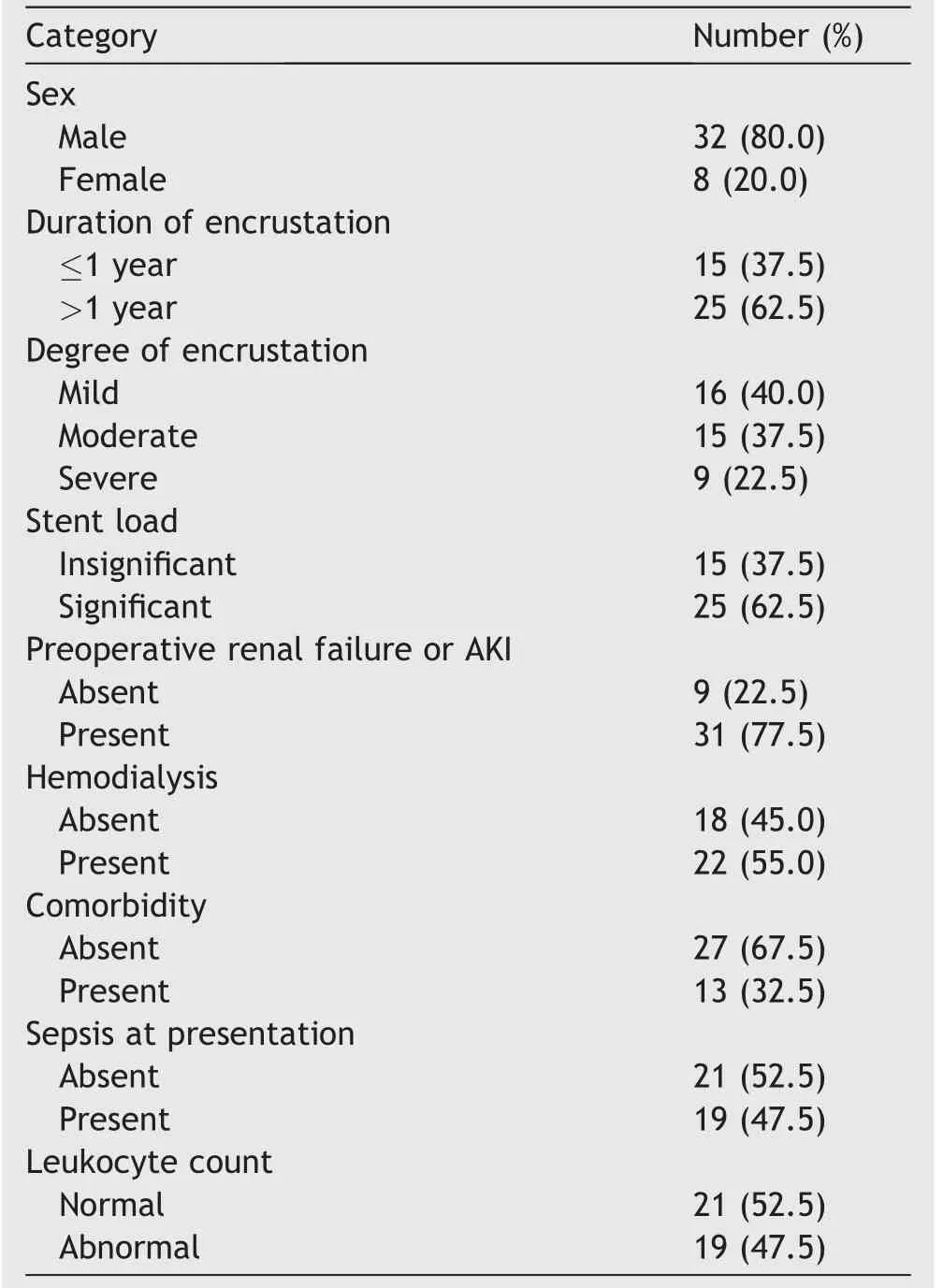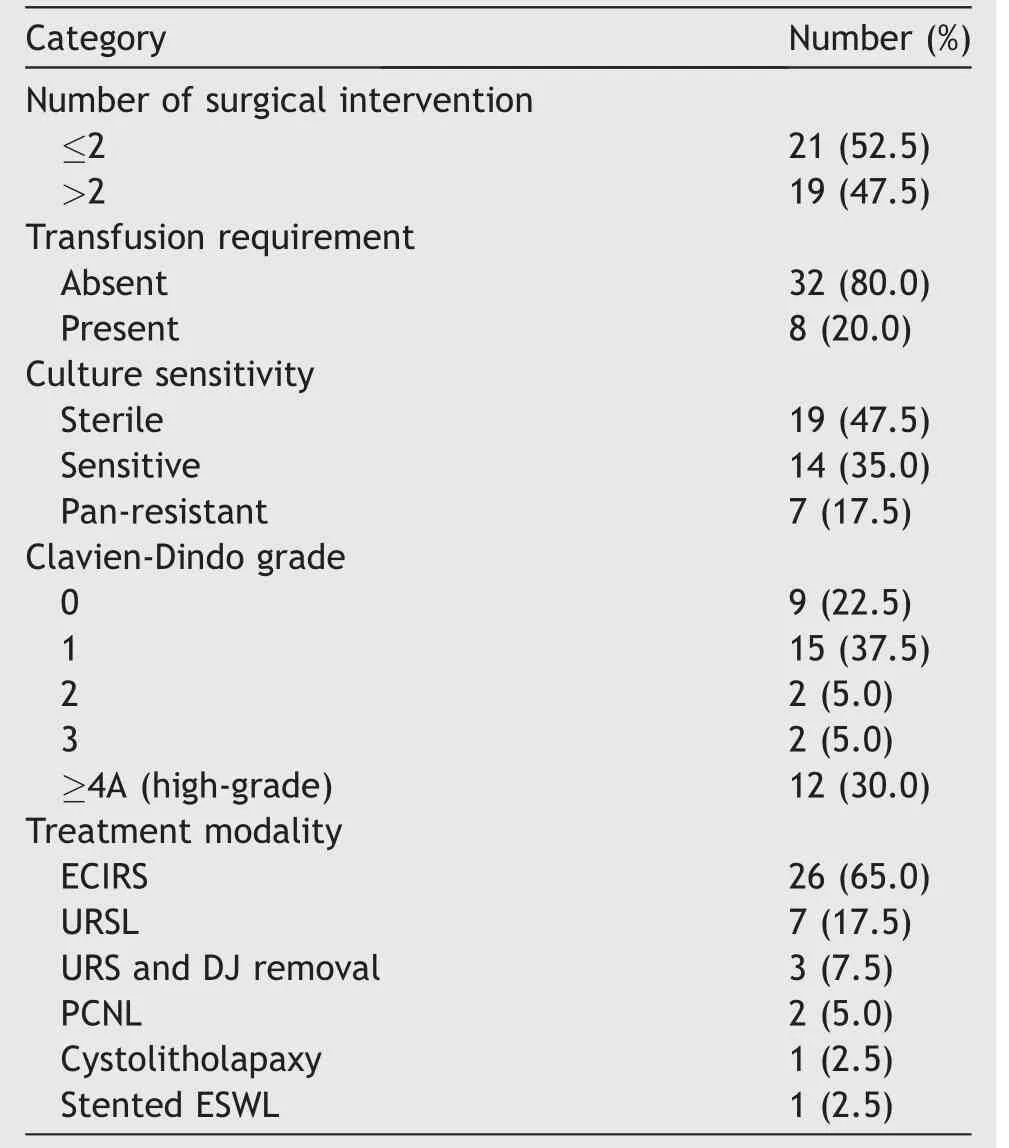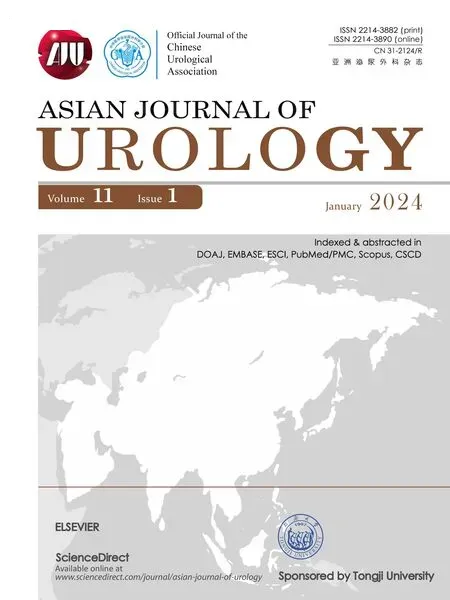Can we predict the incidence of high-grade Clavien-Dindo complications in patients with forgotten encrusted stents undergoing endourologic management?
2024-02-25PraanjalGuptaRamanitharanManikandanLalgudiNarayananDorairajanKodakattilSreenivasanSreeragSidharthaKalraSwapnilSinghKushwaha
Praanjal Gupta,Ramanitharan Manikandan,Lalgudi Narayanan Dorairajan,Kodakattil Sreenivasan Sreerag,Sidhartha Kalra,Swapnil Singh Kushwaha
Department of Urology,Jawaharlal Institute of Postgraduate Medical Education and Research,Pondicherry,India
KEYWORDS Forgotten;Encrusted stent;Outcome;Predictor;Clavien-Dindo complication
Abstract Objective: Ureteral stents are customarily inserted to facilitate urinary drainage,but they come with their own glitches of being forgotten and/or encrusted leading to serious consequences.The present study aimed to report the complications in patients with forgotten and encrusted stents according to the Clavien-Dindo system specific to urological procedures and identify the factors leading to high-grade(Clavien-Dindo Grade 4A or above)complications.Methods: The hospital records of patients with forgotten encrusted double-J stents over a period of 8 years were reviewed.The parameters recorded included patient demographics,indwelling time,need for percutaneous nephrostomy,hemodialysis,urine culture,blood culture,total blood counts,serum creatinine,radiologic findings,management techniques,number of surgical interventions,modified Clavien-Dindo complications,follow-up,and mortality,if any.Results: Forty patients were included in the study.The median age was 52(range 6-85)years.Of the total,25 (62.5%) patients had a “significant” stent load;31 (77.5%) had renal failure or acute kidney injury on presentation;19 (47.5%) patients had sepsis at presentation.Among the patients presented with sepsis,11 (57.9%) patients demonstrated a positive urine culture;and 7/11 (63.6%) patients exhibited pan-resistant organisms.Twelve out of 40 (30.0%) patients in our series developed high-grade Clavien-Dindo complications.On univariate analysis,sepsis at presentation (p=0.007),stent load (p=0.031),diabetes (p=0.023),positive urine culture(p=0.007),and stent indwelling time of more than 1 year (p=0.031) were found to be significant.On multivariate logistic regression analysis,sepsis at presentation(p=0.017)and positive urine culture (p=0.016) were significant predictors for high-grade complications.Conclusion: It is prudent to identify specific risk factors,namely sepsis at presentation and positive urine culture to triage and optimize these patients before surgical management.
1.Introduction
Ureteral stents are an indispensable armamentarium of the urologists both in elective and emergency surgical interventions.The removal of these stents can sometimes be “forgotten”,which can happen due to poor compliance of patients and lack of timely reminders from the treating urologists,which can be highly prevalent in resource-constrained countries [1,2].A myriad of complications has been attributed to the forgotten double-J (DJ) stent,including hematuria,stent blockage,migration,encrustation,fragmentation,and stone formation[3,4].The above pathophysiology can lead to serious consequences such as recurrent urinary tract infection,urinary tract obstruction,renal failure,and sepsis.Furthermore,removing these forgotten encrusted stents can be technically challenging,entailing multiple complex operative procedures leading to a substantial economic burden for the patients and stress on the healthcare systems[5].
There is a direct correlation between the duration of the indwelling stent and the encrustation burden.As the encrusted stent load increases,surgery becomes more complicated,leading to morbidity,and even mortality,as reported in many series [6].Since a cohort of these patients present with obstructive uropathy and urosepsis,the complication rates are higher when they undergo definitive surgery for stent removal even after pre-operative optimization[7].Presently,there is a lack of studies on the classification of complications in these patients’ cohorts utilizing standardized reporting systems such as Clavien-Dindo classification.The present study aimed to report the complications in these patients according to the Clavien-Dindo system specific to urological procedures and identify the predictive factors leading to high-grade (Grade 4A or above) complications.
2.Materials (patients) and methods
The study was conducted by retrospectively reviewing the hospital records of 40 patients with forgotten encrusted DJ stents in a tertiary care center in South India for over 8 years.The institutional (Jawaharlal Institute of Postgraduate Medical Education and Research,Pondicherry,India) ethics committee approved the study (JIP/358/2022)and informed consents were obtained from all the patients included in the study.Among the 40 patients,25 patients were referred to us from other hospitals,and 15 patients had a history of DJ stent insertion at our institution.The parameters recorded included age,sex,presenting complaints,indications for stent placement,indwelling time,need for percutaneous nephrostomy (PCN),hemodialysis,urine culture,blood culture,total and differential blood counts,serum creatinine,radiologic findings,management techniques,number of surgical interventions,operative time,estimated blood loss,transfusion rates,intensive care admission,modified Clavien-Dindo complications,hospital stay,duration of follow-up,and mortality,if any.For uniformity,we classified all cases with grade lesser than 4A as low-grade and 4A or more as high-grade Clavien-Dindo complications.The inclusion criteria comprised patients with encrusted DJ stents in whom endourological techniques were employed to remove the stents.Exclusion criteria included patients who required nephrectomy for nonfunctioning renal units or open surgery.
The grade of encrustation was categorized on the non-contrast CT findings as mild when the encrustation in the upper tracts (in the ureter or along with the upper coil of the stent) was less than 5 mm in maximum diameter,moderate when the diameter was between 5 mm and 10 mm,and severe when the encrustation was more than 10 mm[8].The term “stent load” was defined as significant when the stent exhibited either one of the following parameters-moderate or severe encrustation,indwelling time greater than 1 year,or involved both renal units.
2.1.Surgical technique
The patients were started on culture-specific antibiotics pre-operatively if urine culture was positive.PCN was placed in patients presenting with pyonephrosis and obstructive uropathy with or without hemodialysis to optimize the renal parameters.Patients underwent cystolithotripsy,ureteroscopy,ureteroscopic lithotripsy,percutaneous nephrolithotomy (PCNL),endoscopic combined intrarenal surgery (ECIRS),or a combination of these techniques in a single or multiple setting depending upon the “stent load”.
Cystolithotripsy was performed using a 24.5 Fr cystoscope sheath with Maurmeyer stone crushing forceps (Karl Storz,Tuttlingen,Germany) or by using the pneumatic lithotripsy system (Swiss Lithoclast Master®,Electro Medical Systems,Nyon,Switzerland).Rigid ureteroscopy was performed using 8.0/9.8 Fr and 6.0/7.5 Fr semi-rigid ureteroscope.PCNL was performed in the standard fashion employing 24 Fr nephroscope over a 28/30 Fr Amplatz sheath (Cook Medical LLC®,Bloomington,MN,USA).ECIRS was performed in the modified Galdakao-Valdivia position with two surgeons (Manikandan R and Dorairajan LN)operating simultaneously in the antegrade and retrograde technique.ECIRS was generally adopted when the stents demonstrated encrustation concurrently involving the renal and the ureteral segments.The ergonomics of this strategy enabled rapid lithotripsy of the encrustations,and accelerated downstream flow of the calculi leading to faster evacuation and a shorter operative time.The surgeons routinely performed flexible nephroscopy during PCNL to ensure complete clearance of the encrustations before concluding the procedure.In all of the above endourological procedures,a low-pressure irrigation system was maintained to prevent urosepsis.
At the end of the procedure,a DJ stent was placed in patients with severely encrusted stents with ureteral edema to facilitate urinary drainage.The stents were subsequently removed after 2-3 weeks.Similarly,a nephrostomy tube was placed in patients undergoing PCNL.The nephrostomy tubes were removed at 24-48 h.Post-operatively,a non-contrast CT scan of kidneys,ureters,and bladder was obtained to ensure encrustation-free status.The postoperative course was evaluated by the modified Clavien-Dindo classification system for complications,which was taken as the outcome measure.The patients were reviewed at 3-month follow-up with serum creatinine and ultrasonography if deemed necessary.
2.2.Statistical analysis
Statistical analyses were performed using IBM®SPSS statistics,version 19.0 (IBM®Corp.,Armonk,NY,USA).All the categorical variables were summarized as frequency and percentage.All the continuous variables were summarized as mean and standard deviation (SD),median and interquartile range depending upon the distribution of the variable.The normality of the continuous variables was assessed using the Kolmogorov-Smirnov test.Univariate logistic regression was performed to assess the potential risk factors associated with high-grade complications.The significant variables were then included in the multivariable logistic regression to establish the factors causing high-grade complications.All the statistical analyses were performed at a 5% level of significance,and ap-value of<0.05 was considered statistically significant.
3.Results
A total of 40 patients with forgotten and encrusted stents were included in our study population.The median age was 52(range 6-85)years.Of the patients,80.0%(32/40) were males,and 20.0% (8/40) were females.The mean duration of encrustation was 2.00 years (SD 1.10 years;range 3.96-60.00 months);25(62.5%)patients had either Grade 2 or Grade 3 encrustations or more than 1-year duration of encrustations,or bilateral encrustations,i.e.,had “significant” stent load;31 (77.5%) patients had renal failure or acute kidney injury on presentation and among them,22(71.0%) patients required hemodialysis for pre-operative optimization.Out of 40 patients,10 (25.0%) patients were diabetic;8 (20.0%) had hypertension;19 (47.5%) patients had sepsis at presentation with elevated leukocyte counts.Among the patients presented with sepsis,11/19 (57.9%)demonstrated a positive urine culture;Escherichia coli(72.0%) was the commonest organism,followed byPseudomonas(18.0%) andEnterobacter(9.0%).
Totally,26/40 (65.0%) patients underwent ECIRS,7/40 (17.5%) ureteroscopic lithotripsy,3 (7.5%)ureteroscopy and DJ removal,2(5.0%)PCNL,followed by 1(2.5%) stented ESWL,and 1 (2.5%) cystolitholapaxy.Out of 40 patients in our series,12 (30.0%) developed high-grade Clavien-Dindo complications.Among these,11/12 (91.7%)patients had significant stent load,and 10/12 (83.3%) patients had sepsis at presentation.Totally,22 (55.0%) patients had undergone PCN pre-operatively;10/22 (45.5%)reported high-grade Clavien-Dindo complications;17/22(77.3%) patients had positive urine cultures;20/22 (90.9%)had significant stent load;and 15/22 (68.2%) had sepsis at presentation.Among patients with low-grade complications(28 patients),10 had positive urine cultures,responded well with culture-specific antibiotics and had a better post-operative outcome.Seven (17.5%) patients out of 40 had pan-resistant bacteria in their urine culture,and all of them encountered Clavien-Dindo complication Grade 4A(Tables 1 and 2).
On univariate analysis,we found sepsis at presentation(p=0.007),stent load (p=0.031),diabetes (p=0.023),urine culture positivity (p=0.007),number of surgeries more than two (p=0.023),and more than 1-year duration of stent (p=0.031) with significant association leading to high-grade Clavien-Dindo complication.On multivariate logistic regression analysis,only sepsis at presentation(p=0.017)and positive urine culture(p=0.016)were found to be significant.Number of surgeries more than two was nearly significant (p=0.067) (Table 3).Besides,a signifi-cant correlation was found between pan-resistance and high-grade (4A) Clavien-Dindo complication (p<0.002).

Table 1 Preoperative parameters assessed among the 40 patients with forgotten encrusted stents.

Table 2 Perioperative parameters assessed among the 40 patients with forgotten encrusted stents.

Table 3 Predictors of high-grade Clavien-Dindo (≥4A)complications in patients with forgotten encrusted stents.
4.Discussion
A ureteral stent is an integral part of the urologic practice,and it facilitates urinary drainage from the kidney to the bladder and is generally considered safe and well-tolerated[1].However,short-or long-term usage of stents comes with attendant complications.The duration of the indwelling stent to be regarded as “forgotten” is still a contentious topic.Contemporary studies consider a variable period of 3-6 months for a stent to be termed as “forgotten”.A forgotten stent is different from a retained stent,which is irretrievable cystoscopically requiring further auxiliary intervention [8,9].In our study,a forgotten DJ stent was defined as a stent that was left in the system for longer than 3 months unless intended by the physician.
The forgotten stent has a myriad of clinical presentations.The commonest presenting symptoms include flank pain (25.3%),irritative bladder symptoms (18.8%),hematuria (18.1%),and fever (12.3%) [10].An asymptomatic patient is more likely to neglect or forget his stent and hence develop encrustation,fragmentation,and obstruction [11].Stent encrustation occurs due to continued exposure to urine,biofilm formation that subsequently calcifies,causing encrustation and frank stone formation.This,in turn,leads to stent entrapment [12].Encrustation plays a significant role in the complications and morbidity of patients with ureteral stents [11].Certain factors are known to affect encrustation,most importantly being the indwelling time.An increase in encrustation rate from 9.2% in less than 6 weeks to 47.5% between 6 and 12 weeks,and up to 76.3% in later than 12 weeks was reported by el-Faqih et al.[3].The indwelling times had been varied in different studies with median times ranging from 14 months to 28 months.Further past history of recurrent urolithiasis had been found to increase the risk of encrustation by three times [9,13,14].The potential risk factors causing stent encrustation are the type of stent material,history of urolithiasis,concentrations of urinary substances,the existence of bacterial colonization,lack of health insurance,male gender,and pregnancy [9,14-16].
Though the risk factors leading to stent encrustation have been extensively published in the literature,there is still a paucity of evidence identifying the factors affecting the outcomes in managing the patients with encrusted stents.In our study,12 (30.0%) patients encountered high-grade Clavien-Dindo complications in the peri-operative period.On univariate analysis,the risk factors such as sepsis at presentation,stent load,diabetes,urine culture positivity,requirement of more than two surgical interventions,and stent indwelling time of more than 1 year were predictors for high-grade Clavien-Dindo complications.However,on multivariate regression analysis,only sepsis at presentation (p=0.017)and positive urine culture (p=0.016) were statistically significant.It is interesting to note that among the twelve patients with high-grade Clavien-Dindo complications,all had renal failure in the pre-operative period;10/12 (83.3%) required a PCN;and 11/12 (91.7%) had positive urine cultures.Intriguingly,among this subset of patients requiring pre-operative urinary diversion,sepsis at presentation and positive urine cultures significantly led to high-grade Clavien-Dindo complications,p<0.038 andp<0.013,respectively.None of the previous studies have compared the pre-operative factors which may modulate the outcome of the patients.However,Abdelaziz et al.[15]studied the correlations between the risk factors (stent duration,lack of urine acidification,history of stone formation,and elevated creatinine) and the complications of forgotten ureteral stents (urinary infection,encrustation,stent fragmentation,complicated endoscopic technique,and post-operative need of stent replacement).They found the duration of the stent and non-acidified urine to be significantly causing encrustation and management difficulties.The proximal stone burden portends severe encrustations making the surgical removal an arduous task [14].Prolonged retention of stents also enhanced bacteriuria and systemic diseases[7].Reducing the dwell time minimizes the encrusted stent complications,particularly in those having concurrent diabetes and renal impairment [12].Also,renal failure can be a deterrent if associated with prolonged indwelling times,poor compliance,and pyelonephritis.PCN can be planned in these patients initially,followed by definite surgery about 2-4 weeks later [17].
In our series,positive urine cultures were commonly observed in patients with diabetes,obstructive uropathy,and prolonged indwelling times (>3 months).Among those with high-grade Clavien-Dindo complications,11/12(91.7%)had positive cultures.Further pan-resistance was found to be significantly correlated with high-grade complications(p<0.002).There are lacunae in the published English literature on the effect of urine culture data on stent encrustations and the related afflictions after their surgical management.Pan-resistant organisms can be attributed to the pathophysiology of stent encrustation,which involves biofilms formation.It has been observed that bacterial organisms can potentially acquire early drug resistance in biofilms.Biofilms promote bacterial persistence by not letting the antimicrobial drug diffuse adequately to reach minimum inhibitory concentration.Further,they are in a reduced metabolic state,which confounds the drug’s action over the pathogenic microbes [7,16,18].With the emerging antibiotic resistance patterns of the bacteria and over-the-counter usage of empirical therapy,multidrug-resistant organisms have evolved,particularly in developing countries.These organisms may herald a poor prognosis to the patients with retained stents.Sepsis at presentation can be due to various reasons,predominantly being urinary tract infections.Judicious use of antibiotics,strict monitoring of patient vitals,and urine output with adequate hydration entail the management of sepsis.Long indwelling time seems to affect the infection rate of encrusted stents [12,19].Perhaps,larger stone burden(>10 cm2)and multiple puncture tracts have been found to worsen the inflammatory response in patients undergoing PCNL [20].
There is not a single standardized grading system for measuring the severity of forgotten encrusted stents.Previously reported grading systems include the Kidneys,Ureters and Bladder score and Forgotten,Encrusted,Calcified score,predicting stent-and stone-free status.Despite the anecdotal evidence,a standardized and validated scoring system has not yet been developed [21,22].Our study demonstrated “stent load” involving the indwelling time,size of the upper coil encrustation,and laterality.It was found to be significantly predicting worse outcomes in patients with forgotten encrusted stents.Perhaps,this shall create new avenues for research for developing a new grading system for streamlining the management of forgotten encrusted stents and their post-operative outcomes.
In spite of the number of times Susan had visited with us, our invitations were never returned. She wants you to come, too, so you can meet her foster mom. The words foster mom dangled11 in the air like a spent birthday balloon. Susan never talked about her home life, and we didn t find it necessary to pry12.
The management of an encrusted stent can be a challenge to the urologist.There are various endourologic management approaches depending on the duration,grade,and site of encrustation [23].Endourologic procedures can provide a safe solution for the retained stents,simultaneously preserving the renal function [24].Newer retrograde endourological approaches using the laser are considered in the safe management of encrusted stents,albeit avoiding longer operative time [25].
Our study demonstrated a significantly higher incidence(30.0%) of life-threatening Clavien-Dindo complications than the routine PCNL procedure,in which only 0.53% had life-threatening complications [26].This asserts that even after successfully managing a forgotten encrusted stent,the post-operative period may take a boisterous turn leading to septic complications,putting the patient on a transplant waiting list,and even death [7].Thus,it is prudent to identify the significant predictors of high-grade Clavien-Dindo complications as our study demonstrated,namely sepsis at presentation and positive urine cultures prior to management of the encrusted stents,which may serve as eye-openers for intensive management of these patients.It may further aid in the timely prognostication of the patients.Moreover,as these factors can help predict poorer post-operative outcomes regarding the need for further dialysis,channelizing these subsets of patients to pre-emptive intervention and strict post-operative monitoring shall be considered to enhance their recovery.
Being a retrospective study conducted in a tertiary care centre,it could be prone to a selection bias wherein most patients had higher risks of infection and complex presentations.Further,our modest sample size may have yielded suboptimal results.However,discovering novel predictive factors entailing high-grade Clavien-Dindo complications shall suggest opportunities for further multi-institutional prospective studies to validate our results.
5.Conclusion
Sepsis at presentation and positive urine cultures may predict high-grade Clavien-Dindo complications in the management of forgotten encrusted stents.Besides raising the alarm for timely intervention and intense monitoring,they help in risk stratification and prognostication of this subset of patients.
Author contributions
Protocol or project development:Ramanitharan Manikandan,Praanjal Gupta,Lalgudi Narayanan Dorairajan,Kodakattil Sreenivasan Sreerag,Sidhartha Kalra,Swapnil Singh Kushwaha.
Data analysis:Praanjal Gupta,Ramanitharan Manikandan,Swapnil Singh Kushwaha.
Manuscript writing or editing:Praanjal Gupta,Ramanitharan Manikandan,Lalgudi Narayanan Dorairajan,Kodakattil Sreenivasan Sreerag,Sidhartha Kalra,Swapnil Singh Kushwaha.
Conflicts of interest
The authors declare no conflict of interest.
杂志排行
Asian Journal of Urology的其它文章
- Primary unifocal penile follicular center non-Hodgkin lymphoma:Report of a rare case and review of the literature
- Efficacy of tadalafil on improvement of men with erectile dysfunction caused by COVID-19:A randomized placebo-controlled trial
- Robotic-assisted retroperitoneal lymph node dissection for stage II testicular cancer
- First report of the histopathological effect of electrocautery using on the urethral taste rosea during glans penis injury by incision in rabbits
- Percutaneous antegrade management of large proximal ureteral stones using non-papillary puncture
- Predictive factors for percutaneous nephrolithotomy bleeding risks
